The Center for Comparative Genomics (CCG) is the Academy's core genomics and sequencing center. Explore the variety of projects the CCG team is currently working on, from A to Z.
Beetles
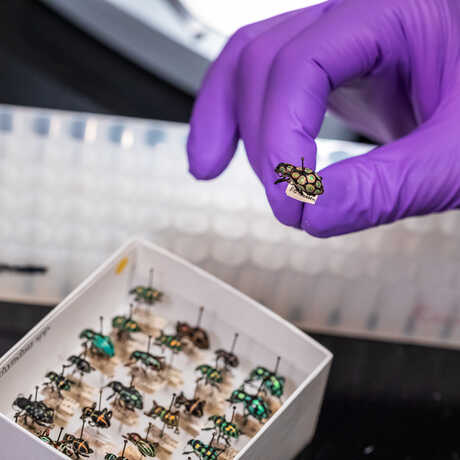
Easter egg weevils (aka jewel weevils) are flightless beetles endemic to the Philippines and surrounding archipelagos. Although they are found in many ecosystems—from coastal forests to cloud forests—their flightlessness, in part, results in many narrowly distributed species. In places where multiple Pachyrhynchus species are present, they tend to converge on a single color pattern to deter predators. This type of convergence is known as Müllerian mimicry, which occurs when multiple unpalatable species evolve to share similar external characteristics to avoid predation. Although these weevils do not secrete any toxins, their hard exoskeletons are nearly impenetrable to predators—and are even known to break or bend the pins scientists use to prepare them.
To better understand the evolutionary origins of mimicry in Pachyrhynchus, we use a combination of phylogenomics, biogeography, and functional genomic studies. In addition, we use next-generation sequencing methods on newly collected samples and specimens found in natural history collections.
This research is led by Research Scientist of Coleoptera, Dr. Matthew Van Dam; Director of CCG, Dr. Athena Lam; and Associate professor at Davao Oriental State University, Dr Analyn Cabra.
Photo: Gayle Laird © California Academy of Sciences
Birds
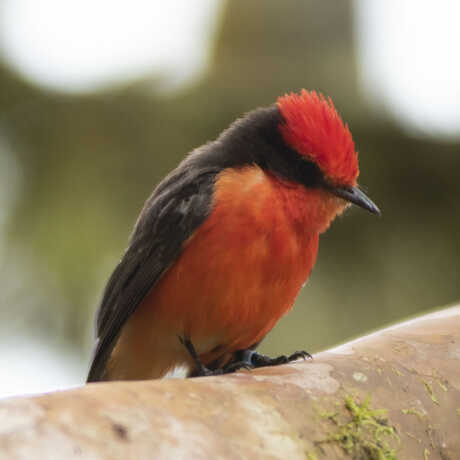
Vermilion flycatcher:
David Anchundia, Charles Darwin Foundation researcher and PhD student at the University of Vienna, Austria, is studying the rare and declining Galápagos little vermilion flycatchers (Pyrocephalus nanus) and least vermilion flycatchers (Pyrocephalus dubius) to understand their evolutionary history and to make conservation-related management decisions.
At the California Academy of Sciences, David sequenced and assembled a whole reference genome of Galápagos vermilion flycatchers, and additionally sequenced whole genomes from about 60 more individuals from different Galápagos populations. The work will help replace extinct populations and will inform genetic management decisions of others.
Photo: Jack Dumbacher © California Academy of Sciences
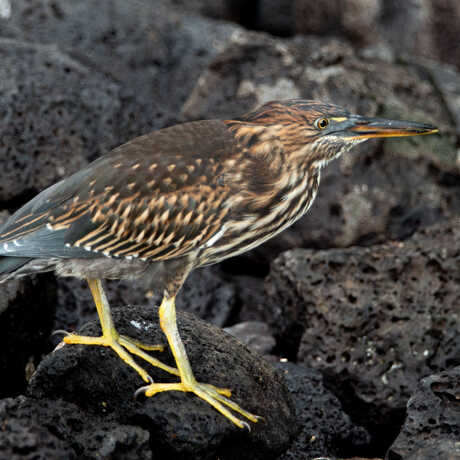
Striated heron:
Master's candidate Ezra Mendales is investigating the taxonomy and global radiation of the cosmopolitan striated heron (genus Butorides). Thanks to CCG's resources, Ezra has been able to extract ultra-conserved elements and sequence these regions of the genome to understand where this group originated and how it proceeded to populate the world. Particular attention is being paid to the endemic Galápagos lava heron to investigate whether this population should be elevated to its own species rank based on its stark morphological and genetic variation versus its mainland counterpart.
Photo: Jack Dumbacher © California Academy of Sciences
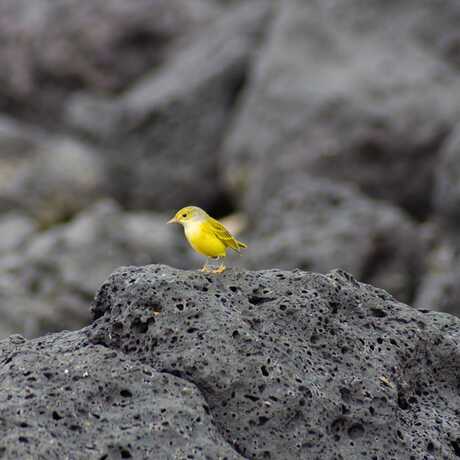
Yellow warbler:
Master’s student Pooneh Kalhori is working with Academy Curator Jack Dumbacher to study elevational adaptation in the Galápagos yellow warbler (Setophaga petechia aureola), a subspecies of Setophaga petechia endemic to the Galápagos and Cocos Islands. The project uses low-coverage whole genome sequencing data from samples collected across different elevations from three Galápagos islands to examine signatures of selection and elevational differences at a genomic level.
Photo: © Adan Deeb
California Insect Barcode Initiative

Museums house an extraordinary amount of species information linked with identified voucher specimens. This is an untapped resource for understanding how biodiversity has changed across California and for developing robust databases on known taxa. Using the large entomological collection at the Academy as well as insect collections at other museums across the state, Postdoctoral researcher Dr. Anna Holmquist and Lab Technician Holly Tavris are generating 100,000 DNA barcodes from Californian insects. This reference library will enable researchers and practitioners to rapidly identify species in a given system using eDNA and other metabarcoding approaches, providing an invaluable resource for biodiversity monitoring in the face of anthropogenic change. This state-funded project is part of Governor Newsom’s 30x30 executive order to conserve 30% of California land and coastal waters by 2030.
Photo: Gayle Laird © California Academy of Sciences
Corals
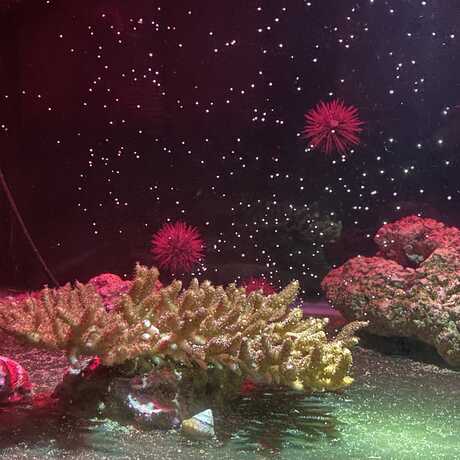
Coral Regeneration Lab (CoRL):
Postdoctoral researcher Elora López-Nandam and Assistant Curator Rebecca Albright are studying the genotypic and phenotypic implications of breeding corals in human care. They are using whole-genome sequencing to track signals of selection between generations of corals that have been bred in the Academy's CoRL.
Photo: Rebecca Albright © California Academy of Sciences
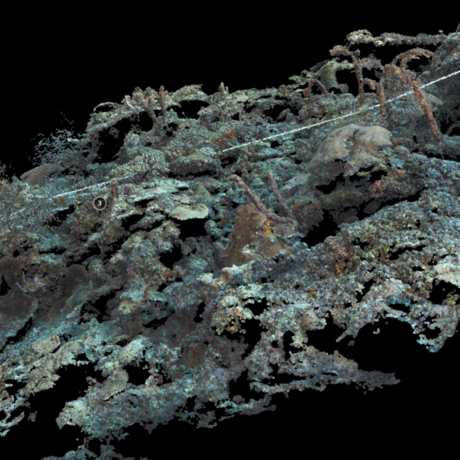
Reefscape Genomics Lab:
The Reefscape Genomics Lab, led by Academy Curator Dr. Pim Bongaerts, researches the ecological and evolutionary processes that drive biodiversity in coral reefs. Using a "reefscape genomic" approach, this research group combines population genomic methods with 3D underwater imaging to simultaneously characterize and georeference the genomes, environments, and phenotypes of tropical coral reef organisms from shallow to mesophotic depths.
Some of the current projects in this group focus on hybridization and adaptation in the genus Madracis (led by postdoctoral research fellow Dr. Jennifer Hoey), conservation genomics of endangered coral species (led by postdoctoral research fellow Dr. Alejandra Hernández), and genomic signatures of coral resilience after bleaching events (led by Dr. Pim Bongaerts).
Image © Reefscape Genomics Lab
Fish
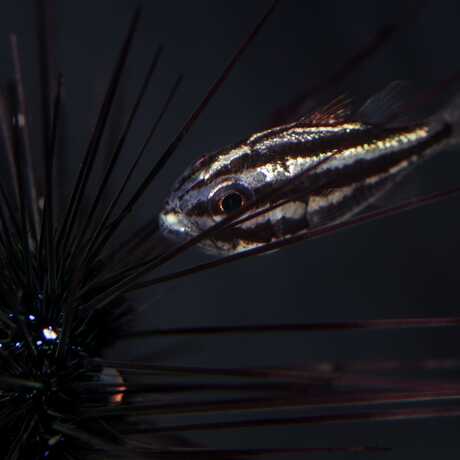
The Gould Lab, led by Research Scientist Dr. Alison Gould, examines the ecology and evolution of bioluminescent symbiosis in the cardinalfish genus Siphamia. Gould's team uses a variety of molecular approaches to understand the specificity of the association within and across host species as well as over space and time.
Ongoing projects include characterizing the strain-level diversity of the microbial symbionts and population genomics of both the host and symbiont throughout the host's broad Indo-Pacific range, and using transcriptomics to decipher the molecular conversation that occurs between host and symbiont. These projects will help reveal how the specificity of microbial symbioses are initiated and maintained over time, and result in the evolution of these critically important and highly specialized associations.
Photo: Alison Gould © California Academy of Sciences
Frogs
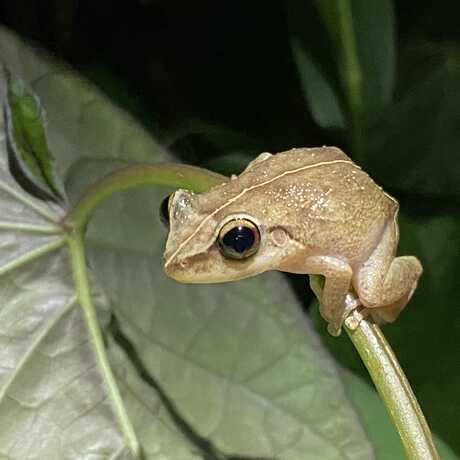
A multi-disciplinary project is currently underway aiming to gain foundational knowledge to develop a robust, well-informed adaptive conservation strategy to prevent Eleutherodactylus (coqui) frogs endemic to the island of Puerto Rico from becoming “threatened” or “endangered,” and to inform ongoing management decisions for species that are already at risk. Through extensive fieldwork and collaboration, the project team has generated landscape genomic datasets for six species that reveal distinct patterns of genetic diversity and potential differences in species' capacity to adapt to future climate change.
This project is led by Academy Curator Dr. Rayna Bell and Postdoctoral Researcher Dr. Kevin Mulder in collaboration with Dr. Jaime Collazo at the US Geological Survey North Carolina Cooperative Fish and Wildlife Research Unit, Dr. Adam Terando and Dr. Mitchell Eaton at the US Geological Survey Southeast Climate Adaptation Science Center, Dr. Alberto Puente Rolón at the University of Puerto Rico - Mayaguez, and Dr. Eloy Martínez at Eastern Illinois University.
Photo © Danielle Rivera
Nudibranchs
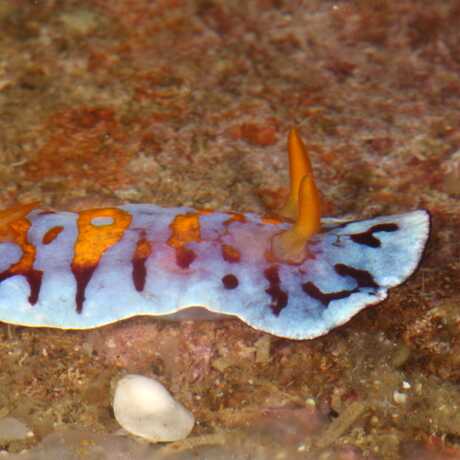
Academy Senior Curator Terry Gosliner has several graduate students and researchers working on various projects covering Nudibranchia and other heterobranch mollusks.
Lynn Bonomo, CCG's lab manager, works on the molecular phylogeny of Chromodorididae from the Indo-Pacific, concentrating on the genus Goniobranchus. Kel Larkin, program manager for the Institute for Biodiversity Science and Sustainability (IBSS), studies the family Arminidae both molecularly and morphologically. Brenna Green, master’s student at San Francisco State University, is researching the Flabellina trilineata species complex along the Pacific coast of North America. Karim Quesada-Khoury, undergraduate at TKTKTK, is studying the molecular phylogenetics of the chromodorid genus Thorunna. Recently graduated master’s students, undergraduate students, and researchers have undertaken studies on Goniodorididae, Discodorididae, Cadlina, and Thecacera through molecular and morphological studies; nematocyst complements in California nudibranchs; and the range expansion of Phidiana hiltoni due to climate change on the California coast. You can see more detailed project information on the Slug Lab website.
Photo © Peri Paleracio
Plants
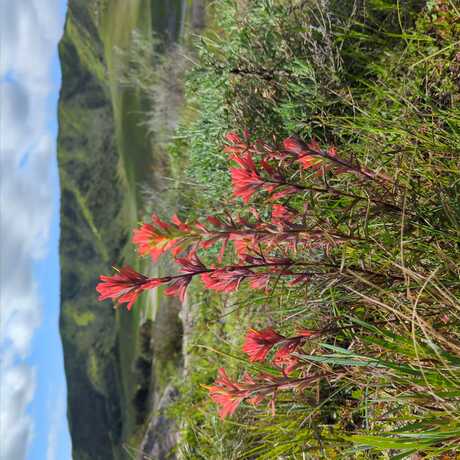
Castilleja:
Academy Curator Sarah Jacobs and her lab members are investigating the evolution of Castilleja (Orobanchaceae), a group of flowering plants native to California and found throughout North and South America. About 200 species of Castilleja—also known as "the paintbrushes"—have been described, but many of their evolutionary relationships are unknown, in part due to their hypervariable nature and ability to hybridize with each other.
The Jacobs Lab is currently focusing on evaluating species relationships of red perennial Castilleja that grow mainly along the California coast. These iconic California native plants are difficult to distinguish in the field, but the researchers are integrating genetic, morphological, and ecological data that will help them assess and characterize species boundaries. In addition, the group is examining how coastal California Castilleja are related to each other, how they have adapted to local environments, how best to identify them in the field, and ultimately how they're related to other species in the genus. To this end, the lab has recently used PacBio Hifi technology to assemble a high-quality, phased genome which provides a reference for comparative genomic and population genetic analyses. In 2023, the team is conducting extensive fieldwork to gather tissue for sequencing, flow cytometry, and chromosome squashes.
Photo © Adriana Hernandez
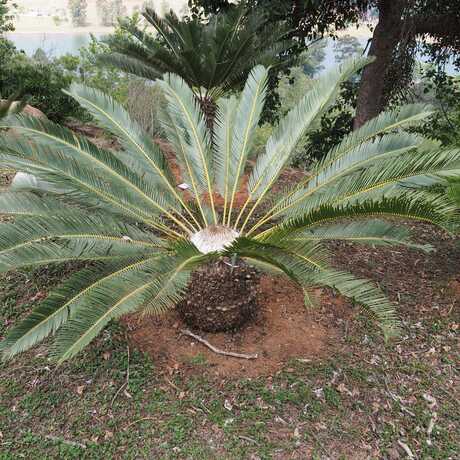
Cycads:
Academy Curator Dr. Nathalie Nagalingum (1975-2022) developed a project with Research Associate Dr. Vanessa Handley to assess the genetic diversity and population structure of functionally extinct-in-the-wild cycads from southern Africa (genus Encephalartos). Research Assistant Maia Jones is using restriction-site associated DNA sequencing data in order to devise conservation strategies for maintaining these species in ex situ populations, for example in botanical gardens.
Photo: Vanessa Handley © California Academy of Sciences
Scorpions and spiders
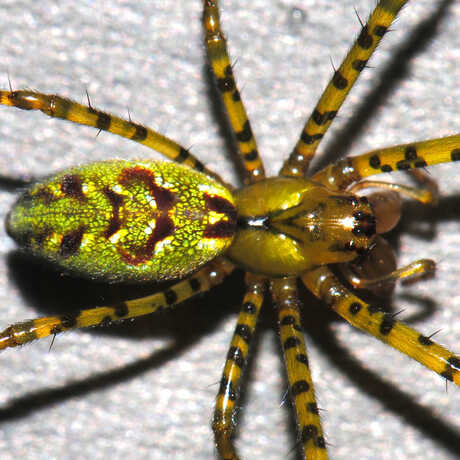
The Arachnology Lab, led by Curator of Arachnology Lauren Esposito, is focused on a wide range of projects that incorporate genomics into understanding the relationships among arachnids and the patterns and processes of arachnid evolution.
Some current projects include: using ultra-conserved elements (UCEs) to build a molecular phylogeny for the spider family Dictynidae, led by graduate student Katherine O. Montana; investigating population genomics, landscape genetics, and conservation of scorpions in the genus Uroctonus (known as Western forest scorpions), led by Jacob A. Gorneau, a graduate student at the University of California, Berkeley; and using UCEs to build a molecular phylogeny of the spider family Selenopidae, led by arachnology researcher Dr. Sarah. C. Crews.
Skinks
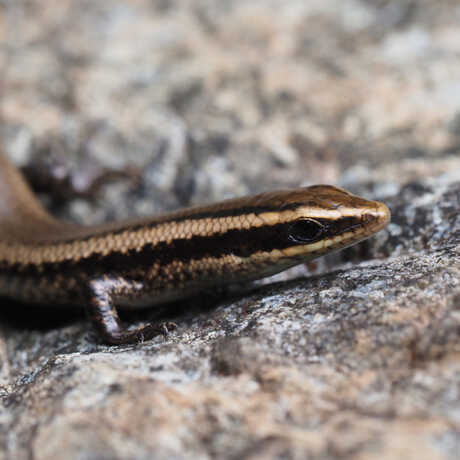
Academy Curator Dr. Rayna Bell and Postdoctoral Researcher Dr. Danielle Rivera are collaborating with Dr. Jaime Collazo and Dr. Nathan Hostetter at the US Geological Survey North Carolina Cooperative Fish and Wildlife Research Unit to inform the species status assessments of eight lizard species endemic to Puerto Rico and the US Virgin Islands.
This collaboration with ecologists and natural resource managers in the US, Puerto Rico, and the US Virgin Islands will inform an upcoming listing decision for the US Endangered Species Act. With the support of the CCG, the team is generating a high-quality reference genome and dozens of low-coverage genomes to clarify evolutionary relationships in the genus and assess the genetic health of remaining populations.
Photo © Jan-Paul Zegarra
Xerces butterfly
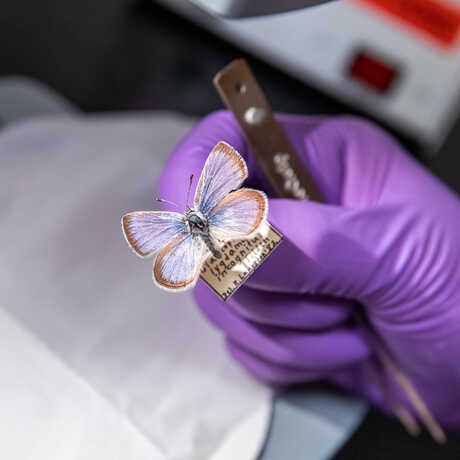
Once found throughout western San Francisco, the Xerces blue butterfly, one of the first documented invertebrates to go extinct due to human-caused habitat destruction, now only exists in museum collections. Academy scientists Athena Lam, Matthew Van Dam, Alizee Gamber, Chris Grinter, David Bettman, Jim Henderson, and Durrell D. Kapan from the CCG and Department of Entomology have extracted DNA and sequenced the genomes of 80-to-100-year-old museum specimens of Xerces and its close relative, the silvery blue (Glaucopsyche lygdamus) to help identify a suitable genomic and ecological replacement for Xerces. By bringing back a "stand-in" for the Xerces blue, the team hopes to rebuild lost ecological connections in San Francisco’s newly restored Presidio dunes and demonstrate how working together can help regenerate the natural world.
Photo: Gayle Laird © California Academy of Sciences